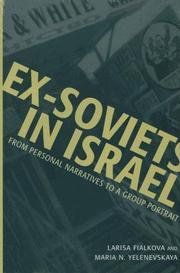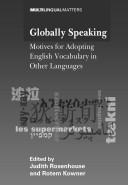| Listing 1 - 4 of 4 |
Sort by
|

ISBN: 0814338399 9780814338391 9780814331699 0814331696 Year: 2007 Publisher: Detroit, MI : Wayne State University Press,
Abstract | Keywords | Export | Availability | Bookmark
 Loading...
Loading...Choose an application
- Reference Manager
- EndNote
- RefWorks (Direct export to RefWorks)
In the final years of the Soviet Union and into the 1990s, Soviet Jews migrated at an unprecedented rate to Israel. Here, ex-Soviets tell their immigration experiences, allowing readers to explore this topic directly through immigrants' thoughts, memories, and feelings, rather than artifacts like magazines, films, or books.
Jews, Soviet --- Immigrants --- Soviet Jews --- Emigrants --- Foreign-born population --- Foreign population --- Foreigners --- Migrants --- Persons --- Aliens --- Cultural assimilation --- Identity. --- Israel --- Ethnic relations.
Book
ISBN: 9949490812 9949490804 Year: 2013 Publisher: Tartu : Eesti Kirjandusmuuseum,
Abstract | Keywords | Export | Availability | Bookmark
 Loading...
Loading...Choose an application
- Reference Manager
- EndNote
- RefWorks (Direct export to RefWorks)
This book is a follow-up to our project devoted to personal narratives of ex-Soviets in Israel. Our original plan was to collect previously published articles dealing with immigration issues but differing from the main themes of our book Ex-Soviets in Israel: From Personal Narratives to a Group Portrait (Fialkova & Yelenevskaya 2007). The themes of immigrants in the city, attitude to law, immigrants' literature and humor were touched upon but not developed in depth in that volume.They were researched in a number of papers written later (Fialkova &Yelenevskaya 2006, 2006a, 2011, 2012, Yelenevskaya & Fialkova 2006,2008) and discussed in our presentations at 11 scholarly conferences.However, when we re-read the articles we realized that the situation in the Russian-speaking community was so dynamic that studies conducted three-five years ago should be seriously revised and updated.
Jews, Soviet --- Cultural assimilation --- Israel --- Ethnic relations.
Book
ISBN: 9781032240985 9780367183660 Year: 2021 Publisher: London Routledge
Abstract | Keywords | Export | Availability | Bookmark
 Loading...
Loading...Choose an application
- Reference Manager
- EndNote
- RefWorks (Direct export to RefWorks)


ISBN: 1783091533 1281878421 9786611878429 1847690521 9781847690524 6611878424 1847690513 9781847690517 Year: 2008 Publisher: Bristol Blue Ridge Summit
Abstract | Keywords | Export | Availability | Bookmark
 Loading...
Loading...Choose an application
- Reference Manager
- EndNote
- RefWorks (Direct export to RefWorks)
This volume accounts for the motives for contemporary lexical borrowing from English, using a comparative approach and a broad cross-cultural perspective. It investigates the processes involved in the penetration of English vocabulary into new environments and the extent of their integration into twelve languages representing several language families, including Icelandic, Dutch, French, Russian, Hungarian, Hebrew, Arabic, Amharic, Persian, Japanese, Taiwan Chinese, and several languages spoken in southern India. Some of these languages are studied here in the context of borrowing for the first time ever. All in all, this volume suggests that the English lexical 'invasion', as it is often referred to, is a natural and inevitable process. It is driven by psycholinguistic, sociolinguistic, and socio-historical factors, of which the primary determinants of variability are associated with ethnic and linguistic diversity.
| Listing 1 - 4 of 4 |
Sort by
|

 Search
Search Feedback
Feedback About UniCat
About UniCat  Help
Help News
News